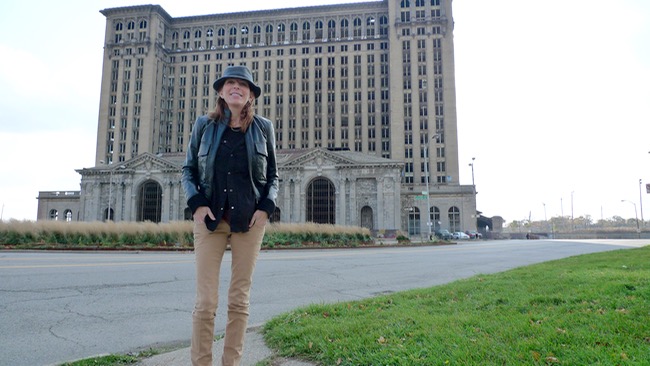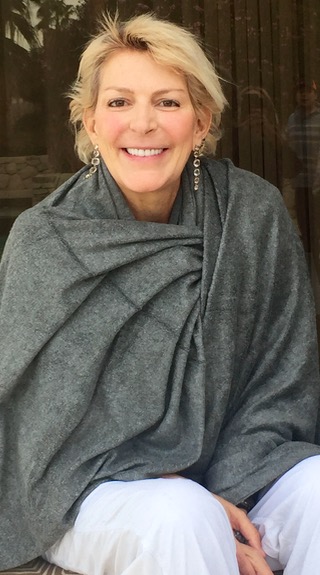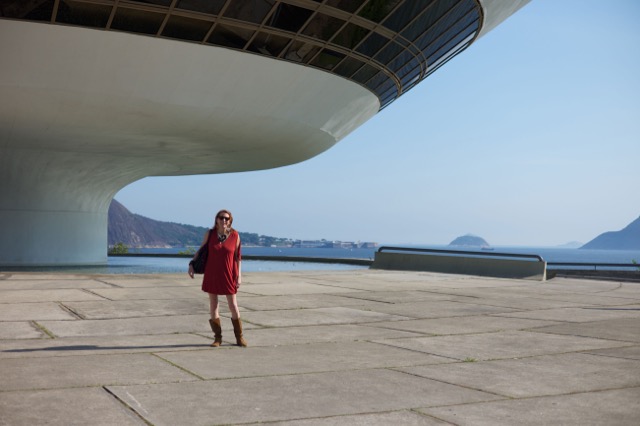Julie was a collage of contradictions. A gourmand who loved Taco Bell. A style setter who took labels off clothes and turned her twin sons’ baby teeth into earrings. A wealthy woman who cared about the underdog. An architecture buff who prized dilapidated factories. A talented photographer. Consummate host. And for me, a good friend.
Julie’s funeral took place on the birthday of her adored father-in-law Al. (Sarasotans might recognize the Taubman name as the co-developers of UTC shopping mall.) The funeral fell in the middle of my recent 4-day annual visit to Miraval Spa in AZ with my daughters-in-law. I fretted over what to do.
Finally, I asked myself: WWJD? I knew she’d say, “Are you kidding? Stay with your family.”
Fortified with tissue, I live streamed the funeral. Some highlights…
Big brother Duke Reyes referenced Julie’s decision to install lighting around the Yamasaki-designed sanctuary of Detroit’s Temple Beth El (where the funeral took place). After, when Julie and husband Bobby drove by, she wisecracked, “I can’t believe it took a shiksa to shed some light on a shul.”
Stepson Alexander recalled his mother Linda’s insistence he eat healthy food. When he dined with Julie for the first time, she asked if he’d like Taco Bell. He said, “I began to think divorce might have its advantages.”
Julie and Bobby met on a blind date, Alexander said. Bobcat (Julie’s nickname for him) confessed he’d been on about 50 blind dates. Their son Theo (a magnate in the making) concluded, “That’s a 2% rate of return.”
Daughter Gogo (Ghislaine, 16) shared a letter she’d begun to her mother while she was sick and never had a chance to read. With remarkable composure, she related how her mom taught her to “never second guess my gut.”
Gallerist Terese Reyes spoke of her aunt’s fondness for “weird” people. Of her inclusiveness and creativity as a host. Julie would seat the art director next to the security director from the Met, Terese said. For her niece’s 30th birthday, Julie riffed off Terese’s long dark hair, hanging dozens of black wigs from the ceiling.
Rabbi Joey Krakoff recalled a time when the Taubman plane was grounded due to weather. Julie jumped out, broke off icicles, and used them to make Bloody Marys.
A word about Julie’s personal style. (Who am I kidding? I couldn’t do it justice in 1,000 words.) Until she underwent chemo, she had a mane of wavy red hair and long legs about which I once said, “God sometimes really gets it right.” Her clothes could be oversized, undersized, torn, folded, twisted—always unique and quintessentially chic. To her twin sons’ military-themed bar mitzvah party at an all-but-abandoned factory, Julie wore a red fur heart-shaped shrug.
Julie’s Bloomfield Hills, MI, home overflowed with objects she prized. A distorted portrait of her by world famous artist Francesco Clemente hung among many by less known artists, including Detroit’s Nancy Mitchnick. Nancy told me, “Julie didn’t care what anyone thought of her taste. When she loved something, that was IT.”
Julie left no surface unturned. Art was everywhere. Drawings even leaned against the wall under the powder room sink. The ceiling of her living room was dotted with colorful “pills” by Cranbrook Artist-in-Residence Beverly Fishman. (Julie was an avid Cranbrook supporter.) With white sweeping roofs and curved glass walls, the dramatic home she and Bobby recently created in the Hamptons looks extraterrestrial.
 Julie was more than a patron. She was a photographer and historian. She spent 7 years cruising around Detroit photographing old, crumbling factories and homes and getting those images ready. (Off-duty policemen accompanied her in dicier neighborhoods.) The result: a stunning (and heavy) book, Detroit: 138 Square Miles. In her acknowledgments, Julie writes, “…listen to the stories only ruins can tell. They tell us a lot about who we were, what we once valued most, and where we may be going.”
Julie was more than a patron. She was a photographer and historian. She spent 7 years cruising around Detroit photographing old, crumbling factories and homes and getting those images ready. (Off-duty policemen accompanied her in dicier neighborhoods.) The result: a stunning (and heavy) book, Detroit: 138 Square Miles. In her acknowledgments, Julie writes, “…listen to the stories only ruins can tell. They tell us a lot about who we were, what we once valued most, and where we may be going.”
Spending so much time away from the D, I didn’t see Julie as often as I’d have liked. (And she wasn’t big on email.) But I treasure the times we did share.
Julie, Bobby, Gogo and twins Theo and Sebs visited our farm in NoMI in summer, 2013. Julie mentioned she was working on a film about Elmore Leonard. The best-selling author of Get Shorty and many other crime novels, Leonard lived in Birmingham, MI. Determined to get him to write the forward for her book, Julie made several fruitless attempts. She finally won Leonard over when she showed up at his door with his daughter-in-law and a half gallon of rose.
I mentioned my regret at never having met the famous author. He’d—not surprisingly—become her friend. She was working on a film about him. It was typical Julie—to jump into something she knew nothing about and be confident she could pull it off. Julie said Leonard dined with her family about once a week, on Thursdays.
I said, “If I were ever in town…”
One Thursday, on my way from the airport, I called. Join us, Julie said. Not only did I score a photo with the world-famous author, who died months later. I got to enjoy his and Julie’s sparring about politics over a delicious dinner. And I drove Leonard home. My car reeked of smoke from Virginia Slims. But it was Bucket List worth it.
Several years ago, before anyone realized Detroit’s cool factor, Julie scented its potential. W Magazine did a fashion shoot in the D. I wondered how on earth that came about. I soon learned. Julie was friends with the editor.
Julie was also close to gallerist Suzanne Hilberry and art critic Marsha Miro. The threesome decided Detroit needed a contemporary art museum. They made it happen. MOCAD (Museum of Contemporary Art Detroit) began organizing radical exhibits. That led to NY Times coverage. Emerging artists started checking out the city, seeing the factory spaces available, cheap, and moving to town. An exciting art scene began to thrive.
Malcolm Gladwell regards leaders as Influencers or Connectors. Julie was both.
The last time I saw Julie, I had a chance to thank her for the difference she’d made in my once downtrodden hometown. Her energy at that point was focused on staying alive. But she heard me. Julie was a catalyst not only for change in Detroit’s image, but in the way Detroiters feel about ourselves.
Recently Burton and I saw Paul Anka at the Van Wezel in Sarasota. He talked about an encounter he’d had with Frank Sinatra in Las Vegas. Sinatra said, “Kid, you’ve written songs for everyone else. When you gonna write one for me?” That night Anka went back to his hotel room and penned the lyrics that sparked a resurgence of Sinatra’s career. That song was played during the recessional for Julie’s funeral. It was perfect for the occasion: “My Way.”
At one point, Julie was pondering a message with which to sign her book. She considered using the phrase “Rust in Peace.” I don’t know how many books she signed that way. (Ours says, “With much love and gratitude.”) I do know this: Julie was a Supernova. A dazzling star who burned out way too soon.
Julie, for those you left behind, you’ll forever be a shining, sophisticated, creative force for good. In our hearts, you’ll never rust.






Thanks so much, Chris. Julie loved you, too. Your work appears in every corner of her stunning home.
as emailed from Chris Schanck
The piece you wrote is beyond words. You gave me goosebumps and brought a tear to my eye. Thank you for sharing some of your stories about Julie, how wonderful, courageous and hilarious she was. A supernova indeed!
Julie was our biggest patron and champion, through the fledgling beginnings of the studio to our more recent success, she was there at every key moment. I can honestly say we would not be where we are today without her creativity, generosity and friendship.
Beautiful recollection of an incredible woman, Suzy.
Thanks so much, Debra. Such a loss.
You nailed it. Great job. Your best ever
Thanks, Pal. That’s high praise from a major fan.
This is a wonderful tribute, Suzy. I love your “collage of contradictions.” I hadn’t known about her role with MOCAD, either. How great!
reply from Suzy:
Thanks, Rodney. I had used the word “tangle,” but “collage” popped into my head and I couldn’t resist a fist bump. Glad you enjoyed. Julie was a force. She lived more in 50 years than most do in twice that time.
Thank you for sharing your memories and those of Julie’s friends.
Thanks for commenting, Shirley. Such a loss.
Oh my goodness. Your beautiful tribute to your friend leaves me feeling like I missed knowing a great woman. I’m so sorry for your loss Suzy.
What an inspiration!
A wonderful tribute. Our world is a less shiny and bright without her.
THanks, Peg. Appreciate your comment. So true.
I knew Julie and loved her too ! Your writing describes it all so perfectly . Though I know you were right to stay with your family , I wish you had been to the Mass at 11 the morning of her funeral . Monsignor Vela from Chicago , the Reyes family priest was incredible . GoGo read , Billy Reyes spoke
and sun poured through the stained glass windows and soaked Julie’s coffin in color .
Jules is gone too soon , too soon .
suzy
a beautiful homage to julie. thank you for sharing. i never knew her but wished i had.
Thanks, Brenda. Wish you’d known each other. You’re both beyond amazing.
Julie lit up everyone’s life- she came to my 70 th 1 week after the twins were born looking glamorous with her red hair flowing, high boots. And anforgeous figure never knowing she had given birth to twins earlier in the week. Seeing her at Alfred’s 90 th birthday she flowed absolutely lit up the room. I wasn’t going tongonit was a month after I lost Henry
But she and Bobby called insisting I come for Henry. Alfred and Henry went all the way back to early days with wives number 1, travelled, divorced and ran wild together until Al
Married Judy. I met the whole family 36 years ago and attrndednAlexanders Briss.
I had the pleasure of being with the incredible family each beyond kind, loving, and devoted to close friends. Julie was her own person- and our world has lost a shining star. We will all miss her but she left andorever legacy for those of us who knew her and loved her. She was taken too early but her life was lived more in her short time here than in many lives living in their 80’s and 90’s. She will sadly
Be missed.
Really lovely— she was an indomitable spirit for sure. LOVED that lady !
Lovely capture of a pioneering spirit. I wish I had known her. I think you’ve done her life justice. We’ll dine, Suzy.
Thanks, Karen. She was a gem. Appreciate your comment.